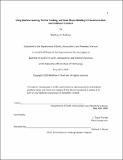Using machine learning, particle tracking, and grain shape modeling to characterize bedƯload sediment transport
Author(s)
Rushlow , Matthew R.S.B.Massachusetts Institute of Technology.
Download1193556873-MIT.pdf (2.387Mb)
Other Contributors
Massachusetts Institute of Technology. Department of Earth, Atmospheric, and Planetary Sciences.
Advisor
J. Taylor Perron.
Terms of use
Metadata
Show full item recordAbstract
Rivers are generally understood through their bulk characteristics and on a river by river scale, while the motion and characteristics of the individual sediment that progresses through those rivers is poorly understood. This project sought to track the bed-load transport of individual natural and artificial sediment grains through a flume to understand the effects of grain shape on motion, and creation of multi spherical approximations of natural sediment grains for use in numerical simulations. Machine learning tools processed the position of millions of grains through a flume. Successful identification and tracking of nearly 75% of all grains within a flume, and multi spherical approximations of natural grains using 20 spheres or less that reproduced important shape characteristics of natural grains were achieved. Accurate grain locations allowed the possibility for velocities, accelerations, entrainments, and flux to be studied with uniquely high resolution. Efficient flume simulations that better represent actual sediment became possible.
Description
Thesis: S.B., Massachusetts Institute of Technology, Department of Earth, Atmospheric, and Planetary Sciences, May, 2020 Cataloged from the official PDF of thesis. Includes bibliographical references (pages 39-41).
Date issued
2020Department
Massachusetts Institute of Technology. Department of Earth, Atmospheric, and Planetary SciencesPublisher
Massachusetts Institute of Technology
Keywords
Earth, Atmospheric, and Planetary Sciences.